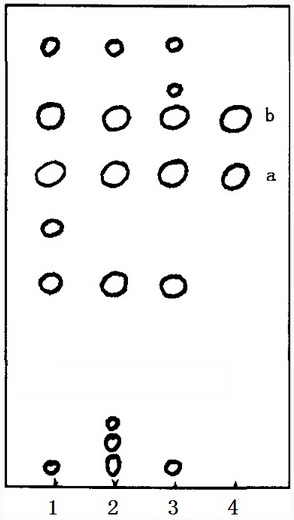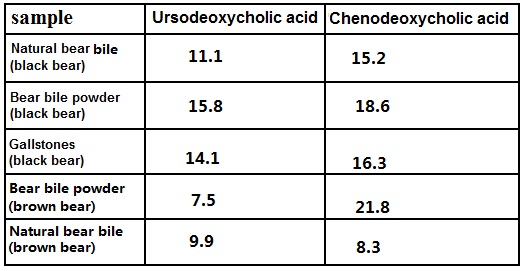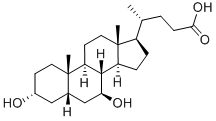| Ursodeoxycholic acid Usage And Synthesis |
| Choleretic drugs |
Choleretic drugs are generally divided into two major categories: Choleretic agents and liquid-increase Choleretic agent. The former refers to the drug can promote the secretion of bile. The latter one refers only to those drugs which can increase capacity without increasing bile. The most commonly used Choleretic drugs is mainly cholic acid class-based such as sodium dehydroepiandrosterone acid, chenodeoxycholic acid and ursodeoxycholic acid and so on.
Ursodeoxycholic acid is a chemical agent of natural bile acid which is isolated from the bile of bear. It is the stereo-isomer of chenodeoxycholic acid. It has a similar litholysis effect, efficacy as chenodeoxycholic acid. However, it has a short course of treatment and a small dose. It is bound with taurine in the bile in vivo, and is a hydrophilic bile acids as well as a dissolving agent of cholesterol. It can reduce the secretion of cholesterol in the liver, lower the saturation content of cholesterol in bile, promote the secretion of bile acids, and increase the solubility of cholesterol in the bile so that cholesterol gallstones can be dissolved or prevented. Moreover, it can increase the secretion amount of bile, and have a choleretic effect by relaxing the bile duct mouth sphincter which smoothen the discharge of calculus. This product, however, cannot dissolve other types of gallstones. Ursodeoxycholic acid is useful in the treatment of cholesterol stones, hyperlipidemia, bile secretion disorders, primary biliary cirrhosis, chronic hepatitis, bile reflux gastritis and prevention of liver allograft rejection and reaction. The calculus-dissolving effect of this product is slightly weaker than the CDCA. |
| Pharmacological effects |
Ursodeoxycholic acid, namely 3α, 7 β-dihydroxy bile acid, is the 7β-hydroxy epimer of chenodeoxycholic acid. Because of this small structural difference, the product is hydrophilic. It can reduce the activity of the rate-limiting enzyme in cholesterol synthesis in the liver--β-hydroxyl-β-methylglutaryl coenzyme A (HMG-CoA) reductase, thus inhibiting the cholesterol synthesis. It also forms a stable liquid crystalline suspension with cholesterol, and thus unsaturated the bile cholesterol, thereby promoting the separation and dissolution of cholesterol stone. This product can also inhibit the intestinal absorption of cholesterol. Ursodeoxycholic acid can also antagonize the cytotoxic effects of endogenous hydrophobic bile acids, protecting the liver cell membrane. By reducing the overexpression of the main membrane tissue compatibility antigen MHC-1, it can inhibit the production of interleukin-2,4, tumor necrosis factor and interferon α; and increasing the body's levels of interleukin-10,12; It also directly binds to the glucocorticoid receptor, playing a role in immune regulation. In addition, Ursodeoxycholic acid can also inhibit apoptosis, inhibit inflammation, scavenge free radical and have antioxidant effects. After oral administration, it is absorbed through non-ionic passive diffusion in the jejunum, and through active transport in the ileum. The effect of first-pass is large, 50% to 75% of the orally administrated dose is uptake by liver. It is mainly distributed in the liver, intestines and blood plasma, and has a 96% to 99% plasma protein binding rate. Ursodeoxycholic acid concentration in the bile exhibit dose-dependent increase; upon a dose of 20~30mg/(kg ? d), its concentration in bile is over 60%, reaching the best therapeutic effect. It binds to glycine, taurine in the liver, and is metabolized by intestinal. A small part of metabolite product is excreted from by urine, mostly by the fecal excretion. Biological half-life of oral administration is 3.5 to 5.8 days.
The above information is edited by the Chemicalbook of Dai Xiongfeng. |
| Chenodeoxycholic acid |
Chenodeoxycholic acid is white needles-like, mp 119 °C, almost insoluble in water, soluble in methanol and ethanol. This product is a gallstone dissolving agent which have dissolving effect on radiative and transparent cholesterol stones in functional gallbladder. By inhibiting the activity of hepatic β-hydroxy-β-methylglutaryl coenzyme A reductase, blocking the cholesterol biosynthesis, reducing the ratio of bile cholesterol to cholic acid, lowering the saturation of cholesterol, so that the stones will be dissolved for prevention the formation of new stones. In the bile of cholesterol gallstone patients, the ratio of chenodeoxycholic acid over other bile acid significantly decreases. The main metabolite of CDCA is lithocholic acid whose 3-sulfate vinegar conjugates secreted from bile to the intestines will be no longer reabsorbed. It can also be partially converted back to ursodeoxycholic acid through dehydrogenation of the 7-keto lithocholic acid.
For clinically treatment of cholelithiasis using chenodeoxycholic acid, use a daily dose of 15mg/kg. Long-term continuously oral administration has effect on dissolving gallstone or reducing its volume. It is especially suitable for treating high levels of cholesterol in gallstones, with diameter 1~2cm, smooth surface, and transparent cholelithiasis through X-ray. The gallstones of some patients relapse after stopping using. In addition, there are reports that this product can reduce triglyceride and cholesterol for patients of high blood serum. Adverse reactions include diarrhea and elevated level of serum transaminases.

Figure 1 The chemical structure of Chenodeoxycholic acid |
| Drug Interactions |
(1) In combination with chenodeoxycholic acid, the effect of promoting cholesterol level and de-saturation in bile were more than single drugs. The effect is also greater than that of the sum of the two drugs.
(2) This product is not suitable taken together with cholestyramine or antacids containing aluminum hydroxide for not affecting the absorption.
(3) Oral contraceptives may affect the efficacy of the product. |
| Side effects |
Has a small effect than chenodeoxycholic acid. It generally doesn’t cause diarrhea. Occasional occurrence of constipation, allergies, headaches, dizziness, pancreatitis, and tachycardia. |
| Precautions |
(1) For elderly patients, apply with caution.
(2) Long-term use can increase the number of peripheral platelet.
(3) If biliary colic occurs recurrently during the treatment of cholesterol gallstones and the symptoms are not alleviated or even become worse or clear stones calcification happen, stop the treatment and apply surgery.
(4) This product cannot used to dissolve bile pigment stones, mixed stones and stones cannot be penetrated by X-ray.
(5) Check liver function regularly during the treatment. |
| Determination of the content ursodeoxycholic acid and chenodeoxycholic acid in bear bile by TLCS method |
(1) Tested sample: The dried bile of brown bear Ursus arctos Linnaeus or black bear Selenarctos thibetanus G.Cuvier.
(2) Chromatographic conditions: High silica gel thin layer plate (Yantai); isooctane-isopropyl ether-acetic acid-butanol-water (6: 3: 3: 1.8: 0.6) as developing solvent; 5% sulfuric acid-ethanol solution of saturated ammonium bisulfate as coloring agents; Spray for coloring, heat at 110 °C for 10min, check the spot position in natural light under 365nm UV lamp.
(3) The preparation of the reference solution: Precisely weigh reference samples of ursodeoxycholic acid, chenodeoxycholic acid, bile acid. Dissolve it in methanol to obtain a reference solution of 1mg per milliliter.
(4) Preparation of sample solution: Precisely weigh 8mg bear bile, add 1.5 mL 30% sodium hydroxide solution, hydrolyze for 10 h in a boiling water bath. Adjust pH to 1~2 with concentrated hydrochloric, extract with ethyl acetate (10ml × 2 times, 5ml × 2 times), combine the extract and concentrate into 2 mL in volume flask, as the sample solution.
(5) Determination: Pipette 1μl sample solution and reference solution 1μl and 2μl, respectively. Crossly dot the samples in the same plate, According to the above-mentioned TLC conditions, develop, take out, dry, and color. Apply reflection zigzag scanning method according TLCS scanning protocol, use excitation wavelength of ursodeoxycholic acid λ ex = 380nm, emission wavelength λ em = 450nm; For chenodeoxycholic acid and bile acids, use λem = 470nm, λex = 550nm. Measure the absorption integral value of sample and reference sample, calculate and obtain the final result.
(6) Chromatograms

Figure 2 The TLC diagram of bear bile using TLCS method.
Notes: 1 natural bear bile; 2 bile powder; 3 Bears gallstones; 4 Reference sample;
a. ursodeoxycholic acid; b.goose deoxycholate acid.
(7) measurement results

Figure 3 The content of ursodeoxycholic acid and chenodeoxycholic acid in bear bile |
| Chemical Properties |
White powder; odorless, bitter taste. M.p.: 200-204 °C. Highly soluble in ethanol and glacial acetic acid, soluble in sodium hydroxide solution but insoluble in chloroform. UDCA is the isomer of CDCA, which has stronger stone-dissolving effect than CDCA and cause no diarrhea and liver toxicity. UDCA can reduce the absorption of cholesterol, and can reduce the synthesis of cholesterol and the level of cholesterol in bile. In addition, UDCA can also reduce the concanavalin A-binding fragment. The substance can also promote the formation of bile crystallize, thereby inhibiting the formation of stones. Applying the UDCA and CDCA in combination can enhance their effect when used alone while also reducing side effects. The combination of these two drugs is mainly for the treatment of cholesterol gallstones. UDCA has a fastest rate of dissolving stone when patient’s bile and stone have similar density or the CT value of gallstone is lower than 75 units. Cholelithiasis patients will have increased peripheral platelet number after using this product. |
| Uses |
1. Gallstone-dissolving drugs. Mainly used for the treatment of inoperable cholesterol gallstones, it will have a cure rate especially in the case when gallbladder is basically normal, stones have a 15mm or lower diameters, X-ray penetrable, non-calcified and high-floating cholesterol stones. It also has some therapeutic effect against toxic hepatitis, cholecystitis, primary sclerosing cholangitis, and primary cholestatic cirrhosis. It can also improve the efficacy of α-interferon on treatment of chronic hepatitis C. It can also used to treat diarrhea, rare constipation, allergic reactions, itching, headache, dizziness, stomach pain, pancreatitis and bradycardia Patients of completely biliary obstruction or severe liver dysfunction and pregnant women should avoid using.
2. For the prevention and treatment of cholesterol gallstones.
3. Anionic detergents, for biochemical research. |
| Production method |
Method 1: Use chenodeoxycholic acid as raw materials
Preparation of 3α, 7α-diacetyl cholic acid methyl ester; Take 36ml of anhydrous methanol, and pass through 1g dried hydrogen chloride gas, add bile acid 12g, stir, heat and reflux for 20-30min. After standing for several hours at room temperature when crystals are separated out, freeze, filter, wash with ether, and dry to obtain methyl cholate. Take 2g methyl cholate, add 9.6 mL of benzene, 2.4mL pyridine, 2.4 mL of acetic anhydride, shake for 10-15min, stand for 20h at room temperature, then pour the reaction mixture into 100ml of water, remove the benzene layer, repeatedly wash with distilled water before recycling the solvents. Wash the solid residue with petroleum ether once, and re-crystallize with methanol-aqueous solution to obtain 3α, 7α-diacetyl bile acid methyl ester.
Bile acid methyl → → 3α, 7α-diacetyl bile acid methyl ester
Preparation of Chenodeoxycholic acid: Take the 1.5 g diacetyl bile acid methyl ester, add 24 mL acetic acid, add potassium chromate solution (Take 0.76g potassium chromate to dissolve it in 1.8ml take in water), heated to 40 °C, perform reaction for 8h, add water 120ml, shaking for some moment, placed 12h, filter, wash with distilled water till neutralization, dry to give 3α, 7α-diacetoxy-12-keto bile acid methyl ester, referred briefly as the 12-ketone. Take 12-15 g 12-ketone, add 150 mL 2-glycol ether, 15 mL 80% hydrazine hydrate solution, and 15 g potassium hydroxide. Heat to 30 °C and reflux for 15h, heat to 195-200 °C, refluxed for 2.5h, heat to 217 °C for some moment of reaction cool to 190 °C, add 0.7ml hydrazine hydrate solution, heat from within 215 °C to 220 °C within 3h, cool, add 600mL distilled water, adjust to pH 3 with 10% sulfuric acid, separate out the crystals, filter, wash with water until neutralization. Add ethyl acetate, dump the aqueous layer, use water to wash the organic layer was washed for 1-2 times, vacuum distillation and obtain 3α, 7α-dihydroxy cholanic acid, namely Chenodeoxycholic acid.
3α, 7α-diacetyl methyl cholate → 3α, 7α-diacetoxy-12-Keto ursodeoxycholic acid methyl ester → 3α, 7α-dihydroxy ursodeoxycholic acid (Chenodeoxycholic acid)
Preparation of refined ursodeoxycholic acid; Taken 2 g chenodeoxycholic acid, add 100ml of acetic acid and 20g potassium acetate, shake to dissolve. Add potassium chromate 1.5g (dissolved in 10 mL of water), at room temperature overnight, add water 200ml, separate out the crystals, filter, wash, and dry to obtain 3α-hydroxy-7-keto-ursodeoxycholic acid. Take 4g 3α-hydroxy-7-keto-ursodeoxycholic acid, add 100 mL n-butanol, heat to about 115 °C, gradually add 8 g metal sodium after which, white slurry gradually comes out, keep reaction for 30min, add 120ml water, stir and heat to transparently dissolve. Evaporate the organic layer under reduced pressure; add 500 mL water to the residue, dissolve, and filter. Adjust the pH the filtrate to pH 3 with 10% sulfuric acid which will yield white precipitate, filter, wash till neutralization with water, dry, wash with ethyl acetate, crystallize with diluted ethanol and obtain 3α, 7β-dihydroxycholanic acid, that’s refined ursodeoxycholic acid.
Chenodeoxycholic acid [potassium chromate] → 3α-hydroxy-7-keto acid [sodium metal, 115 °C] → 3α, 7β-Keto ursodeoxycholic acid methyl ester (Ursodeoxycholic acid)
Method 2: Use pig bile or bile salts as raw material; Use thin layer chromatography to isolate ursodeoxycholic acid from pigs bile or bile salt. Pig bile salt contains free and bound type of UDCA whose content is about 30%; pig bile contains bound UDCA whose content is about 0.6%. |
| Chemical Properties |
WHITE CRYSTALLINE POWDER |
| Uses |
Used as an anticholelithogenic. Epimer with Chenodiol with respect to the hydroxyl group at C7. |
| Uses |
anticonvulsant |
| Uses |
anticholelithogenic; LD50(rat) 890 mg/kg ip |
|






